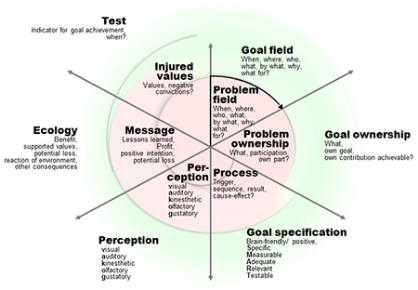Problem/ Goal Specification
The problem/ goal specification provides an efficient description of circumstances that are perceived as difficult or problematic and seem to require change. Changes might be: change of circumstances or change in looking at circumstances. The result will be defined as one goal or a set of goals. Generally the goal/ problem specification will be defined together with the client and/ or the working team at the start of a project or a task to ensure a clear understanding of the initial situation and the results – in any phase of meaning design (i.e. idea development, communication management and business design).
The problem/ goal specification consists of the inner circle of problem specification with the steps: problem field, problem ownership, process, perception, message and injured values. The outer circle of goal specification consists of goal field, goal ownership, goal specification, perception, ecology and test.

Problem specification
The Problem specification detects the initial situation from different perspectives and focuses the problem on aspects that the participants can perceive and control. The following steps can be made successively or in any order. In all cases the problem specification should be fully done prior to the start of the goal specification.
Problem field
The problem field describes the problem frame: the problem occurs what period of time (when), in which environment (where), with whom (who), what happens (what), what is needed (by what), what is important (what) and what is the reason (what for).
Problem ownership
The problem ownership detects the real problem and ensures that the interviewees are involved in the problem. The core elements are the description of the problem (what) and the focusing on those parts, people are involved in (participation) and affected (own part).
Process
The process describes the timely sequence of the problem. The following aspects will be detected: what is initiating the problem situation (trigger); what are the process steps (sequence); what results out of it (result); what mechanisms become visible (cause-effect).
Perception
For all participants it is helpful to describe the situation with all senses: i.e. what can be seen (visual); what can be heard (auditory); what feeling evolve (kinesthetic); what can be smelled (olfactory); what can be tasted (gustatory). Often these perceptions provide new insights concerning the problem situation.
Message
By defining messages that are derived from the problem situation the problem gets further focused. Amongst others the messages can consist of: what can be learned from the situation (lessons learned); are there any advantages out of the situation (profit); what could be intended by the situation (positive intention); what will be threatened by the problem (potential loss).
Injured values
Problem situations are often injuring values. Therefore related values and the way how they get injured will be detected (values) as well as negative convictions that will be confirmed or derived from the situation.
Goal specification
The goal specification describes the desired goal state from different perspectives and enables the participants to understand and accept the goals better. The following steps can be made successively or in any order. In all cases the goal specification should be started after the problem specification has been finished.
Goal field
The goal field describes the goal frame: the goal will be reached what period of time (when), in which environment (where), with whom (who), what happens (what), what is needed (by what), what is important (what) and what is the reason (what for).
Goal ownership
The goal ownership defines the desired goal and ensures that the goal can be reached by the participants. The relevant elements are a concrete description of the goal (what), focus on that goals that are important for the participants (own goals) and that it can be reached by themselves (own part).
Goal specification
The goal specification specifies the goals brain-friendly, positive and accurate. Brain-friendly means that concrete goals are specified (instead of: always – exactly when; everybody – who exactly; everywhere – where exactly). Positive means that instead of negative goal specifications positive ones are used (instead of: not – what exactly; never – when exactly; nobody – who exactly). Accuracy is reached by SMART goal specifications (i.e. S-specific, M-measurable, A-adequate, R-relevant and T-testable goal specification).
Perception
A goal description that is defined by all senses makes it participants easier to commit themselves: i.e. a description of what can be seen (visual); what can be heard (auditory); what feeling evolve (kinesthetic); what can be smelled (olfactory); what can be tasted (gustatory). Often these perceptions provide new insights concerning the goal situation and anchor the goals better.
Ecology
Ecology examines the goal situation holistically. The aspects are: advantages that can be achieved (benefit); values that can be satisfied (values); disadvantages that result from reaching the goal (potential loss); reactions that will be generated by reaching the goal (reaction of environment); effects that might happen (other consequences).
Test
Early specification of indicators that measure the goal achievement improves the result of the change process. Furthermore the point in time for the measurement should be defined. This will define the end of the change process.
